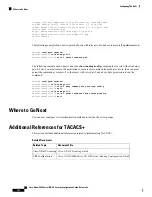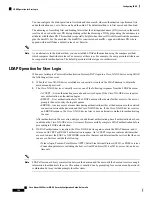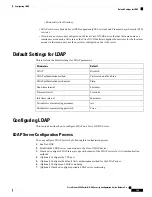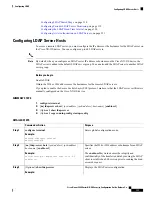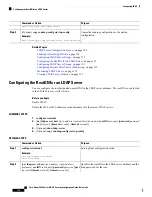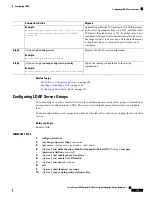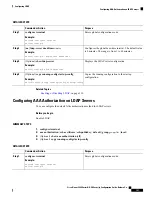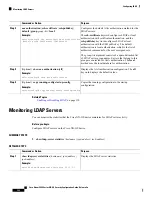
Purpose
Command or Action
switch(config)# show ldap-server
Copies the running configuration to the startup
configuration.
(Optional)
copy running-config startup-config
Example:
Step 4
switch(config)# copy running-config startup-config
Related Topics
LDAP Server Configuration Process
, on page 109
, on page 110
Configuring LDAP Server Groups
, on page 113
Configuring the RootDN for an LDAP Server
, on page 112
Configuring LDAP Server Groups
, on page 113
Configuring Periodic LDAP Server Monitoring
, on page 119
, on page 122
Clearing LDAP Server Statistics
, on page 123
Configuring the RootDN for an LDAP Server
You can configure the root designated name (DN) for the LDAP server database. The rootDN is used to bind
to the LDAP server to verify its state.
Before you begin
Enable LDAP.
Obtain the IPv4 or IPv6 addresses or the hostnames for the remote LDAP servers.
SUMMARY STEPS
1.
configure terminal
2.
[
no
]
ldap-server host
{
ipv4-address
|
ipv6-address
|
hostname
}
rootDN root-name
[
password password
[
port tcp-port
[
timeout seconds
] |
timeout seconds
]]
3.
(Optional)
show ldap-server
4.
(Optional)
copy running-config startup-config
DETAILED STEPS
Purpose
Command or Action
Enters global configuration mode.
configure terminal
Example:
Step 1
switch# configure terminal
switch(config)#
Specifies the rootDN for the LDAP server database and the
bind password for the root.
[
no
]
ldap-server host
{
ipv4-address
|
ipv6-address
|
hostname
}
rootDN root-name
[
password password
[
port
tcp-port
[
timeout seconds
] |
timeout seconds
]]
Step 2
Cisco Nexus 9000 Series NX-OS Security Configuration Guide, Release 9.x
112
Configuring LDAP
Configuring the RootDN for an LDAP Server





